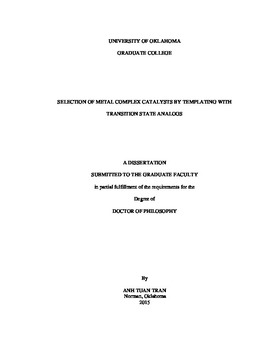| dc.description.abstract | Abstract
Catalysts speed up reactions by providing an alternative, lower energy pathway for the reaction. However, the traditional method of catalyst discovery is time consuming and wastes chemicals. It is important to find a better way of discovering new catalysts preferably with minimal experiments from a collection of catalysts. In this study, transition state analogs (TSAs) were used as templates as a new methodology for catalyst discovery.
In the first chapter, products of hetero Diels-Alder (HDA) reaction between nitroso pyridine and 1,3-pentadiene were used as “late” TSAs for templating with a dynamic library of (imine)Cu+ catalysts. MS quantification was employed as a powerful tool for analyzing the complex library, yielding both peak identification and relative concentration in one experiment. A marginal correlation has been found between library amplification and regioselectivity of the catalysts. Intensive computational studies were also conducted in order to draw a better understanding about the reaction mechanisms and additionally provide a guideline for further catalyst improvement.
The second chapter evaluated the potential of using other imine transition metal complexes: e.g. (imine)Cu2+, (imine)Zn2+, (imine)Ni2+ and (imine)Pd2+ as regioselective catalysts and attempted to use these complexes for templating with TSAs. The Cu2+, Zn2+ and Ni2+ imine complexes catalyze the HDA reaction between 2-nitrosopyridine and 1,3-pentadiene with a small range of selectivity. The templating experiments with these transition metals, however, were not able to draw a better correlation between amplification versus regioselectivity of the catalysts. Computational studies have also been used as a supplemental tool in order to better understand the complex formation and geometry as well as provide a guide to improve the experimental results. In both of the cases, templating with TSAs proved the concept that most regio-selective catalyst can be determined from a library of catalysts with only one set of experiments.
The final chapter investigated the correlation of binding affinity of catalysts to solid-supported substrate analog with catalyst-substrate binding constant and the correlation between binding affinity of catalysts to solid supported trifluoromethyl ketone hydrate as a TSA and rate of the ester hydrolysis reaction. A strong positive correlation with high statistical significance between catalyst-substrate analog binding affinities and catalyst-substrate binding constant was found, which indicates that the substrate analog perfectly mimics substrate-catalyst interaction. A positive correlation with less statistical significance was observed between catalysts-TSA binding and the rate of the catalyzed reactions. With a large set of tested catalysts, 13 (imine)Zn2+ complexes, the experiments proved the concept that affinity chromatography with solid supported substrate analog and TSA can be an effective tool for catalyst discovery. Better TSAs, phosphate esters, and better linkages were also proposed to improve the experimental results. | en_US |
